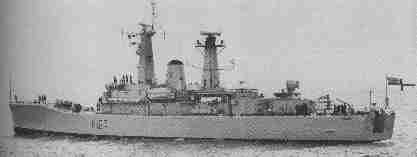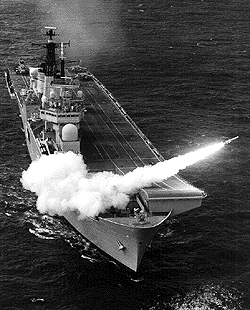British Missile or Drone aircraft?
Following the Irish Government’s investigation completed in 1970 and the conclusion that ‘…there was another aircraft involved is inescapable. No aircraft have been reported missing but there remains the possibility that an un-manned aircraft, either a drone target aircraft or a missile might have been there.’
Speculation immediately centred on Aberporth in West Wales, at the time the most advanced British missile testing station. Frequent missile test firings took place at target drones over the Irish sea.
Several Witnesses in Co. Wexford saw a second aircraft on the morning of March 24th, emerging from a cloud and heard a sonic boom. The Ministry of Defence was quick to point out that Aberporth was closed that day, a Sunday.

Questions have also been raised about the presence of a number of Royal Navy vessels in the area at the time - numbering up to 5 including the Frigate HMS Penelope (below) testing the Sea Dart missile..

[ HMS Penelope - F127 class. Launched 17.8.62, commissioned 31.10.63 to the 20th Frigate Squadron based in Derry, Northern Ireland. Refitted in 1966 at Devonport and became an Admiralty Trials Ship in 1967. In late March 1968 she was in Germany. Fitted out with Exocet capability in 1981, spending a number of years in the South Atlantic following the Falkland's War. Sold in 1991 to the Ecuador Navy and renamed Presidente Eloy Alfaro. Thanks to ships.co.uk for data ]
What is the Sea Dart Missile?

The Sea Dart long range surface-to-air missile, supplied by Matra BAe Dynamics, defends a ship against incoming anti- ship missiles and high speed aircraft. Propulsion is by ramjet and solid boost. The missile is equipped with active and semiactive radar guidance and a high explosive fragmentation warhead detonated by a proximity fuse. Sea Dart has a speed in excess of Mach 2 and a range of more than 40 kilometres.
Specification
Type: Medium-range area-defence missile.
Dimensions: Length 4.36m (14ft 3.65in); diameter 0.42m (1ft 4.54in); span 0.91m (2ft
11.83in).
Weights: Total round 550-kg (1,123-lb); warhead HE-fragmentation.
Performance: Maximum speed Mach 3+; range 65km (40.4 miles); altitude limits 30-18290m
(100-60,000ft).
Ark Royal test firing the SeaDart c. 1975 >
Developments since 1968
23 years after Flight 712, late April, 1991, the crew of an Alitalia MD-80 flying between Kent and London reported that , while passing near the Ministry of Defence's Lydd Firing Range, a missile had passed very close to them. The crew members of the Alitalia aircraft provided detailed descriptions of the missile they had observed. London ATC detected an unidentified image on their radar screens at the time of the alleged near collision between aircraft and missile. Officials of the Ministry of Defence responded to inquiries about the incident with denials that any missile firings had taken place in the area.
Two weeks later there was another incident which caused many persons in Ireland and western England and Wales to wonder about the reliability of the military equipment that is tested in their areas. In this event, a Royal Air Force target drone crashed into a campground, tore the roof from a car turning it into a blazing fireball. Fortunately no one was killed in either incident. In this latter case, the malfunctioning drone had been launched from a test area in Wales - Aberporth.
The two incidents separated by so few days stimulated more than surprise or shock at the possibility that civilians had been endangered by military tests which had somehow flown beyond the normal limits of their test areas. As with the investigation into Flight 712, the terse Ministry of Defence denials of any test exercises in the area of the first incident despite the high degree of credibility of the witnesses and the previous history of Aberporth.
‘Prime Time’ produced by Ireland’s state run television station RTE in 1998 put forward new evidence supporting the theory that EI-712 was hit by a British missile fired from a test range in Wales or from a Navy vessel. The programme also suggested that additional wreckage found in the water was secretly taken back to the UK as it bore evidence of a missile strike. John Giblet, a sailor aboard HMS Penelope claimed that a section of Flight EI-712 undercarriage was taken to a British port instead on an Irish port.
The questions we need to pose are obvious.